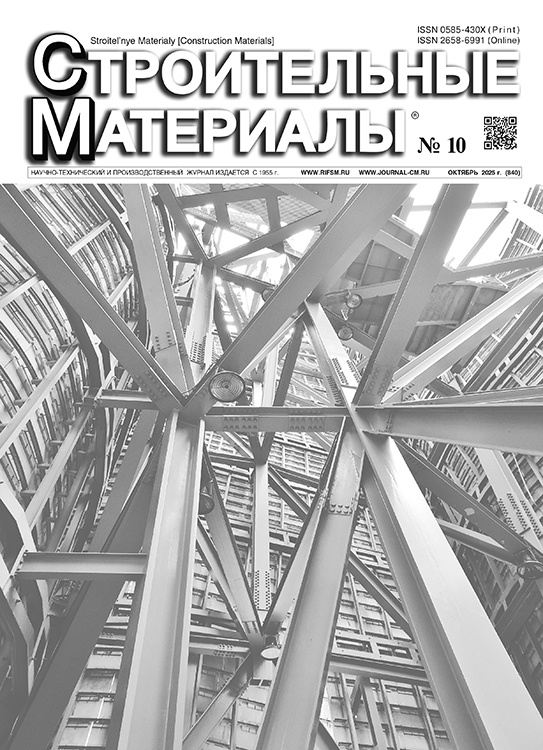Thermodynamic characteristics of the structural modification “forsterite–magnesite”
- 作者: Frolova M.A.1, Lesovik V.S.2, Ayzenshtadt A.M.1, Strokova V.V.2, Danilov V.E.1, Malygina M.A.1
-
隶属关系:
- Lomonosov Northern (Arctic) Federal University
- Belgorod State Technological University named after V.G. Shukhov
- 期: 编号 10 (2025)
- 页面: 76-82
- 栏目: Статьи
- URL: https://journals.eco-vector.com/0585-430X/article/view/695827
- DOI: https://doi.org/10.31659/0585-430X-2025-840-10-76-82
- ID: 695827
如何引用文章
详细
According to the current environmental agenda of the Russian Federation, one of the most important tasks of the building materials industry is to find promising areas for integrated processing and increase the share of man-made raw materials, namely industrial waste. This fully applies to mining and processing plants, the waste of which is large-scale man-made raw material deposits. Based on the thermodynamic analysis, the feasibility of the transformation chain saponite→serpentine→forsterite→magnesite is shown by alternating the stages of mechanochemical activation of raw materials and high-temperature modification of intermediates. Chemical schemes of the mechanism of these transformations leading to the production of magnesia astringent compositions are given. The validity of the theoretical calculations has been experimentally confirmed by methods of differential thermal analysis and IR-spectroscopy. Experimental samples were obtained using a binder based on magnesite synthesized from serpentine. An aqueous solution of bischofite was used as the sealing solution. The tests carried out on their mechanical destruction have shown that the synthesized powders exhibit the properties of binders. Thus, the average values of certain parameters (ρ, Rcomp, and KCC) were: 1600 kg/m3; 5.78 MPa and 3.62 (respectively). The results obtained open up a new promising area of using the multi-tonnage waste of the kimberlite ore dressing process to develop technologies for the production of magnesia binders and a wide range of products based on them.
全文:
作者简介
M. Frolova
Lomonosov Northern (Arctic) Federal University
编辑信件的主要联系方式.
Email: m.aizenstadt@narfu.ru
Candidate of Sciences (Chemistry)
俄罗斯联邦, 17, Severnaya Dvina Embankment, Arkhangelsk, 163002V. Lesovik
Belgorod State Technological University named after V.G. Shukhov
Email: naukavs@mail.ru
Doctor of Sciences (Engineering)
俄罗斯联邦, 46, Kostyukova street, Belgorod, 308012A. Ayzenshtadt
Lomonosov Northern (Arctic) Federal University
Email: a.isenshtadt@narfu.ru
Doctor of Sciences (Chemistry)
俄罗斯联邦, 17, Severnaya Dvina Embankment, Arkhangelsk, 163002V. Strokova
Belgorod State Technological University named after V.G. Shukhov
Email: vvstrokova@gmail.com
Doctor of Sciences (Engineering)
俄罗斯联邦, 46, Kostyukova street, Belgorod, 308012V. Danilov
Lomonosov Northern (Arctic) Federal University
Email: v.danilov@narfu.ru
Candidate of Sciences (Engineering)
俄罗斯联邦, 17, Severnaya Dvina Embankment, Arkhangelsk, 163002M. Malygina
Lomonosov Northern (Arctic) Federal University
Email: m.turobova@narfu.ru
Engineer, Graduate Student
俄罗斯联邦, 17, Severnaya Dvina Embankment, Arkhangelsk, 163002参考
- Umnov V.A. Waste management in the mining industry. Gornyy Informatsionno-Analiticheskiy Byulleten’. 1995. No. 5, pp. 99–106. (In Russian). EDN: NBWUAD
- Shpilevaya (Verzhak) D.V., Garanin K.V. Diamond deposits of the Arkhangelsk region and environmental problems of their development. Vestnik of Moscow University. Series 4: Geology. 2005. No. 6, pp. 18–26. (In Russian). EDN: HTXTGP
- Aizenshtadt A.M., Morozova M.V., Frolova M.A., Tyurin A.M. Study of the possibility of using waste tailings of JSC severalmaz for the production of a mineral additive to cement binders. Obogashchenie Rud. 2024. No. 3, pp. 42–48. (In Russian). EDN: JZOTBF. https://doi.org/10.17580/or.2024.03.07
- Pustovgar A.P., Lukuttsova N.P., Ustinov A.G. Study of the properties of fine-grained concrete modified with a nanodispersed serpentinite additive. Vestnik MGSU. 2013. No. 3, pp. 155–162. (In Russian). EDN: PXOIXB
- Isaakyan A.R., Zulumyan N.O., Melikyan S.A., Beglaryan A.A. Use of hydrosilica gel isolated from serpentines to obtain nanosized β-wollastonite crystals. Zhurnal Fizicheskoy Khimii. 2020. Vol. 94. No. 10, pp. 1533–1538. (In Russian). EDN: RWHFGK. https://doi.org/10.31857/S0044453720100143
- Zyryanova V.N., Berdov G.I. Magnesia binders from brucite beneficiation waste Stroitel’nyye Materialy [Construction Materials]. 2006. No. 4, pp. 61–65. (In Russian). EDN: HTCIYJ
- Averina G.F., Chernykh T.N., Orlov A.A., Kramar L.Ya. dentification of the possibility of using magnesia waste from mining and processing plants for the production of binders. Stroitel’nyye Materialy [Construction Materials]. 2017. No. 5, pp. 86–89. (In Russian). EDN: YQGANZ
- Aizenshtadt A.M., Korolev E.V., Malygina M.A., et al. Structural modification of highly dispersed powders of overburden rocks made of saponite-containing bentonite clay. Fizika i Khimiya Obrabotki Materialov. 2023. No. 1, pp. 56–63. (In Russian). EDN: BGBWRA. https://doi.org/10.30791/0015-3214-2023-1-56-63
- Aizenshtadt A.M., Morozova M.V., Frolova M.A., et al. Saponite-containing waste from mining and processing enterprises – a raw material reserve for the building materials industry. Ekologiya i Promyshlennost’ Rossii. 2024. Vol. 28. No. 7, pp. 20–25. (In Russian). EDN: JLONBM. https://doi.org/10.18412/1816-0395-2024-7-20-25
- Cheng T.W., Ding Y.C., Chiu J.P. A study of synthetic forsterite refractory materials waste using serpentine cutting. Minerals Engineering. 2002. Vol. 15. Iss. 4, pp. 271–275. https://doi.org/10.1016/S0892-6875(02)00021-3
- Sara Lee K.Y., Christopher Chin K.M., Ramesh S., at al. Characterization of forsterite ceramics. Journal of Ceramic Processing Research. 2013. Vol. 14. No. 1, pp. 131–133.
- Herbert Todd Schaef, Bernard P McGrail, John L Loring, Mark E, Bowden, Bruce W Arey, Kevin M Rosso. Forsterite [Mg2SiO4)] carbonation in wet supercritical CO2: an in situ high-pressure X-ray diffraction study. Environ Sci Technol. 2013. Vol. 47 (1), pp. 174–181. https://doi.org/10.1021/es301126f
- Aizenshtadt A.M., Strokova V.V., Nelyubova V.V., et al. Physicochemical transformations of saponite-containing material during its activation by grinding. Fizika i Khimiya Obrabotki Materialov. 2024. No. 1, pp. 53–64. (In Russian). EDN: LSOZOU. https://doi.org/10.30791/0015-3214-2024-1-53-64
- Dorogokupets P.I., Dymshits A.M., Sokolova T.S., et al. Equations of state of forsterite, wadsleyite, ringwoodite, akimotoite, MgSiO3-perovskite and post-perovskite and the phase diagram of the Mg2SiO4 system at pressures up to 130 GPa. Geologiya i Geofizika. 2015. Vol. 56. No. 1–2, pp. 224–246. EDN: TKRZWB. https://doi.org/10.15372/GiG20150111
- Kremenetskaya I.P., Gurevich B.I., Ivanova T.K., Lashchuk V.V., Bubnova T.P. Binding properties of metaserpentine. Tekhnika i Tekhnologiya Silikatov. 2014. Vol. 21. No. 2, pp. 9–16. (In Russian). EDN: SEIWTD
- Korikova O.V., Valova M.S., Titova Yu.A., Murashkevich A.N., Fedorova O.V. Synthesis and spectroscopic study of Si, Ti, Mg, Zn oxides modified with L-proline. Zhurnal Prikladnoy Spektroskopii. 2021. Vol. 88. No. 3, pp. 398–407. (In Russian). EDN: PKHYFB
- Ustinova Yu.V., Nasonova A.E., Nikiforova T.P., Kozlov V.V. Study of the interaction of caustic magnesite with the addition of microsilica. Vestnik MGSU. 2012. No. 3, pp. 100–104. EDN: PDDNAF
补充文件











